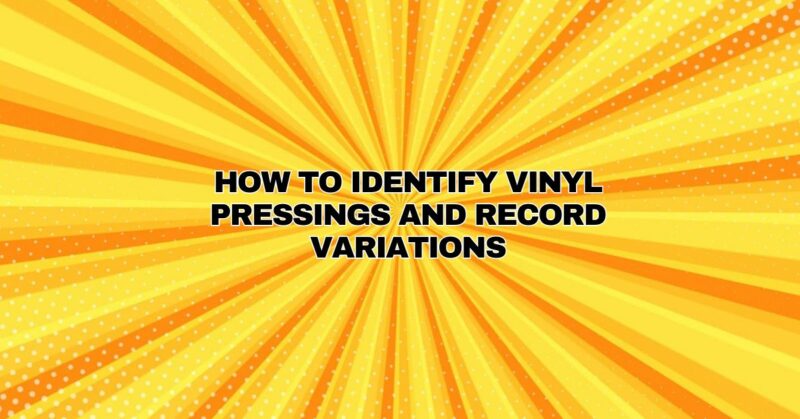Vinyl records have a timeless appeal, captivating music enthusiasts with their warm analog sound and tactile charm. For vinyl collectors, one of the most intriguing aspects of building a collection is identifying vinyl pressings and record variations. Each pressing and edition can have unique characteristics that impact sound quality, rarity, and value. In this comprehensive guide, we’ll explore the techniques and strategies collectors use to identify vinyl pressings and record variations.
1. Understanding the Basics
Before diving into the finer details of vinyl identification, it’s essential to grasp the foundational concepts:
1.1 Vinyl Pressing:
A vinyl pressing refers to a batch of records created from a set of stampers in a single manufacturing run. These pressings are typically numbered sequentially and can vary in quantity, ranging from a few hundred to thousands.
1.2 Record Variation:
Record variations encompass the differences between different editions or pressings of the same album. These variations can include factors like the record label, catalog number, country of manufacture, artwork, and more.
2. Inspecting the Record Label
The record label is one of the primary indicators of a vinyl pressing’s identity. Here’s what to look for:
2.1 Label Design:
Different pressings often feature unique label designs. Examine the label closely, noting any variations in typography, colors, and logos.
2.2 Catalog Number:
The catalog number is a crucial identifier. It’s usually found on the label and may include a prefix indicating the record label or distributor.
2.3 Copyright Information:
Check for copyright information, which can vary between pressings. Look for dates, rights organizations, and other details.
2.4 Country of Manufacture:
The country of manufacture is often printed on the label. Records pressed in different countries may have distinct characteristics.
3. Analyzing the Runout Groove
The runout groove, also known as the matrix or dead wax area, is the blank space between the end of the music on the record and the label. It can hold valuable information:
3.1 Matrix Numbers:
Matrix numbers are etched or stamped into the runout groove. These alphanumeric codes are unique to each pressing and provide crucial identification.
3.2 Mastering Engineer and Cutting Engineer Signatures:
Some records feature signatures or initials of the mastering or cutting engineers. These can be valuable clues in identifying specific pressings.
4. Comparing Cover Art and Packaging
Packaging elements, such as album covers and inserts, can offer insights into record variations:
4.1 Cover Art Changes:
Examine the album cover for variations in artwork, layout, or text. Different pressings may have subtle or significant differences.
4.2 Inserts and Extras:
Some pressings include inserts like lyric sheets, posters, or promotional materials. These extras can be unique to certain editions.
5. Researching Online Resources
Collectors often rely on online resources and databases dedicated to vinyl identification:
5.1 Discogs:
Discogs is a vast online database of music releases. You can search for specific albums, view detailed release information, and contribute to the community’s knowledge.
5.2 Vinyl Forums:
Online vinyl collector forums and communities are excellent places to seek advice and share your findings with experienced collectors.
6. Consulting Experts and Reference Books
For challenging identifications or rare records, consider seeking the expertise of collectors or consulting reference books on vinyl discography.
7. Documenting Your Collection
As you identify pressings and variations, maintain a detailed catalog of your collection. Document the release information, catalog numbers, and any unique characteristics you discover.
Conclusion
Identifying vinyl pressings and record variations is an art that requires a keen eye, attention to detail, and a passion for collecting. While it may be a time-consuming endeavor, the rewards are plentiful. By understanding the basics, inspecting labels and runout grooves, analyzing cover art, utilizing online resources, and documenting your findings, you can build a collection that not only reflects your musical tastes but also serves as a testament to the rich history and diversity of vinyl records. Happy collecting!

